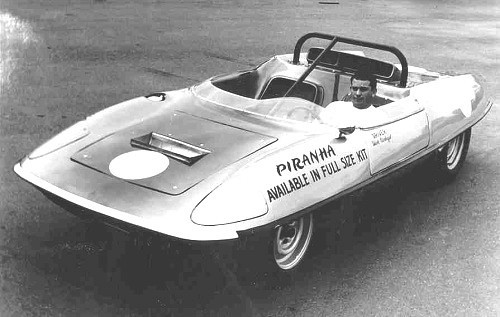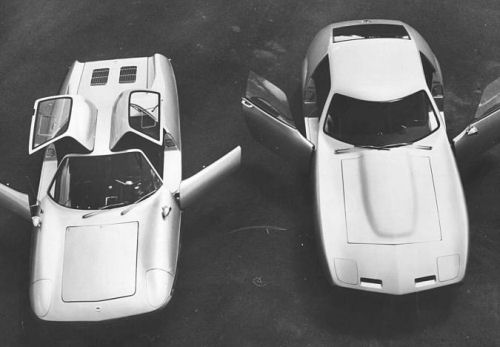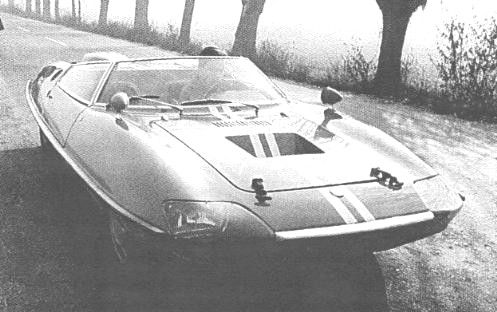INTRODUCTION
A condensed version of the CRV/Piranha story
During the early 60's, automobiles were made mostly of metal. Plastic was starting to be used more frequently, but the plastic companies wanted to do more. Marbon Chemical, a division of Borg-Warner, decided the best way to promote the use of plastic in automobiles would be to build an entire car out of plastic. They hired a young designer by the name of Dann Deaver to come up with the design for the car which was to be "thermoformed" out of the Marbon material called "Cycolac." Deaver's design was not only functional for the molding process, but a striking new style that still looks modern today.
Deaver was also co-founder of Centaur Engineering, which was in the race car business. With the resources of Marbon, and the expertise of Centaur, the first plastic prototype was constructed in late 1964 and first displayed at the SAE convention in Detroit in January 1965. This prototype was called the CRV, short for "Cycolac Research Vehicle." It was a two-seater roadster with a wrap-around windscreen, and featured a rear-mounted, 4-cylinder water-cooled engine. The chassis was based on the Centaur racecar tubular frame.
 |
Workers put the finishing touches on the first CRV prototype
just prior to its' debut in January 1965.
|
The CRV was a hit at the SAE show, so Marbon decided to take the next step and build a more powerful version and race the car in competition to test the durability of the material.
Centaur was commissioned to build the racer and have it ready for an SCCA race at Mid-Ohio in June 1965. It was constructed by Centaur employees and friends. Trant Jarman would be driving the car. As an incentive to finish the car on time, Marbon offered to make Centaur Engineering their Concepts Division. The car was completed on time and Centaur went big time. This second prototype, the CRV-II, was another roadster and was built over a fiberglass chassis tub with suspension pieces attached to metal framework in the front and rear. It was powered by an air-cooled Corvair engine mounted in the rear. Bulges had to be added to the rear fenders to allow for the oversized racing tires. The car did quite well in competition and went on to win it's class in SCCA that year. Even a crash with a Jaguar during one race showed the plastic body was durable enough for everyday use.

|
|
Here is a rare color photo of the CRV-II ready to hit the track. |
The CRV-III was the third prototype build by Centaur, but was not a complete car. It was built for crash testing. Needless to say, plastic cars do not afford a great amount of protection. During the test, the car was demolished and the driver would have been impailed by the stock Corvair steering column that had been used. This was changed to a partially collapsible Toronado steering column on all later cars.
The next step was to build a more practical, street version of the car, so CRV-IV was build in February 1966. It featured a full windshield and coupe roof. The doors opened in the conventional method, but the side windows were part of the roof and opened "gullwing" style. Again, the car was Corvair-powered, and featured two Porsche rear grilles in the top of the rear deck to aid cooling. The gas tank was a cylindrical fiberglass affair that was mounted to the chassis on the passenger side, just in front of the rear wheel. The CRV-IV can be identified by the bullet-shaped mirrors mounted on the front fenders.
 |
CRV-IV was the first coupe version. Note the gullwing door tops
and Porsche grilles in the rear deck. |
A second coupe, CRV-V, was built a short time later, and can be identified by the rectangular mirrors mounted on the doors. Both cars were immediately sent overseas to promote the use of plastic at Marbon's foreign production facilities. It is not confirmed if either car was ever returned to the USA.
It was never Marbon Chemical's intention to manufacture cars, but merely to create a market for their plastic products. They had hoped to find someone that would want to take over production of the CRV so they could sell them the parts. Then along came AMT Corporation of Troy, Michigan. AMT was a major plastic model car manufacturer and was doing very well at that time. They were looking for ways to promote their model products and offering a plastic-bodied specialty car sounded like a natural. They had previously hired California customizer Gene Winfield as a design consultant and parts designer for their model kits. He was offered the job as head of the new AMT division, located in Phoenix, AZ, that would build the plastic sports car and other full-size versions of cars they produced. Winfield also had connections in Hollywood which gave AMT another outlet for specialty cars for TV & movies.
AMT purchased the rights from Marbon to build the plastic car, and agreed to purchase the plastic bodies and fiberglass chassis from them. Originally AMT planned to build 50 cars a year. To promote the new venture, AMT decided to build both a drag racing and sports racing version of the car. They even gave the car a new name, the "Piranha."
The Piranha dragster was build and toured the drag racing circuit in 1967 and was a big hit. It was one of the first rear-engine "funny cars" and almost cracked the 200 MPH barrier. The sports car version was built and campaigned by veteran driver Dick Carbijal.
 |
Besides the well known dragster version, AMT built and sponsored a sports
racing version of the Piranha. It was driven in various events by Dick Carbajal. |
Previously, Winfield had been hired to build a special car for the new TV series "The Man from U.N.C.L.E." from a Dodge Charger, but NBC was having second thoughts about all the free advertising the car would give one of the shows main sponsors. Winfield suggested using a Piranha instead, and thus the "Man from U.N.C.L.E." car became the most well known Piranha. All three of these special AMT cars are now in private hands. The U.N.C.L.E. car and Carbijal racer have both been restored, and the dragster is in the process of being restored.
Soon, AMT started to build the street versions of the 1967 Piranha. Changes from the original CRV design included an extended roofline, small hinged hatches in the side windows, and optional "Gurney bubbles" in the roof for more head room. AMT had planned to offer the Piranha for sale to the public for around $5,000. Unfortunately, due to the high cost of building each car by hand and obtaining the Corvair engines and parts from GM, it cost AMT well over that amount to finish each car. After about four streetcars were completed, and GM announced they were dropping the Corvair very soon, the arrangement between AMT and Marbon broke down. AMT turned over the four unsold Piranha coupes and all the extra parts to Marbon and they parted ways. AMT continued to produce other specialty cars and props for customers (including the Star Trek shuttlecraft) for some time, but closed the Phoenix operation in 1969.
Apparently, Marbon stripped the AMT I.D. plates off the finished Piranhas, added CRV logos to the bodies, and distributed them for display at various company facilities, including their home office in Washington, West Virginia. Some of these cars eventually found their way into private hands. It is also possible that another car or two was assembled from the extra parts returned from AMT.
Marbon did find another customer for the CRV in a kit car company located in Lincoln, Nebraska. The Cycolac bodies were sold as bolt-ons for the VW chassis. They were available in both coupes and roadsters with Marbon furnishing the bodies to the kit car company. Eventually, the company made molds of the body and produced a modified version in fiberglass.
By this time, Marbon Chemical had created a second generation plastic vehicle called "Formacar." A new design had been created, building on the successful testing of the CRV program. One prototype was built and the concept almost sold to American Motors, but there were problems with the new plastic chassis that ultimately killed it. Promotional materials for Formacar often included photos of the new car sitting next to a "CRV" which was actually a Piranha. A sharp eye can detect the modified Piranha roofline, side window "hatches," and bulges in the roof.

|
This Marbon promo shot compares the new Formacar to their earlier CRV.
However, it appears the car is actually one of the AMT Piranhas. |
Centaur went on to design and produce chairs, boats, campers, and other items made from Cycolac, but Marbon eventually changed their focus and closed the doors of their Concepts division and the assets and fixtures were auctioned off. Rumor has it that CRV parts and/or cars were sold at the auction.
Based on this information, at least 12 CRV's and Piranha's were built. In a letter dated 1983, Borg-Warner stated "all these vehicles were purposely destroyed except for one version which was placed in the Smithsonian Institute." Contacts at the Smithsonian state that they do not have one of the cars. However, one car being restored in Michigan has all the parts and indications of being one of the original Marbon prototype coupes.
The three special AMT Piranhas (UNCLE car, Carbajal racer, & dragster) all reside in California.
CRV designer, Dann Deaver, acquired a Piranha for himself, but he is now deceased. The car remains in the Deaver family in Michigan.
The remains of a Piranha is owned by a gentleman in Indiana, but the car was butchered by its' previous owner when he planned to mount it on a tubular chassis with a Capri 6-cylinder engine placed in the front.
Another car has surfaced in Pennsylvania with CRV markings, but sports a Piranha roof. This may be the car that was on display at Marbon's home office in West Virginia. This car is currently being restored.
 |
This car surfaced in Pennsylvania in running condition. It has CRV logos on the body,
but an AMT roofline. The square headlights are being replaced during the restoration. |
That is a total of seven cars that are known to still exist. Rumors persist that either Toyota or Honda have a CRV in a museum in Japan.
One additional car was built overseas by the Italian coachbuilder OSI. We believe Marbon sold or donated a body and chassis to the company, who then added their own styling touches. It appears the car is based on running gear from a Renault Alpine 8/10 1108 Gordini which is a vertical inline 4 cylinder engine. Its' whereabouts is also unknown.
 |
Italian coachbuilder OSI built a stylized version of the CRV. Note the clear
headlight covers, air scoop in hood, and bulge in trunk area. Other photos
help conclude the car was based on Renault running gear. |
In June 2006, the restored Carbijal AMT Piranha racer made its' debut at the Wine Country Classic historic car races at Sears Point Raceway. This will no doubt renew some interest in these forgotten, landmark cars.
This website was created to share information and hopefully open communications with others who have an interest in the CRV's & Piranha's. It did just that. I have hear from car owners, employees that worked on the cars, kids that rode in the cars when their dads brought one home for the weekend, relatives of the drivers, and just plain fans like me.
The rest of the site has not been updated for some time, but contains a lot of details you might enjoy. I hope to update and add more information soon.
If you have any information regarding these cars you would like to share, please feel free to contact me.
NICHOLAS K. WHITLOW nkw1965@aol.com
Piranha Homepage
|






